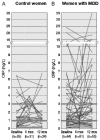Plasma CRP levels in premenopausal women with major depression: a 12-month controlled study
- PMID: 19408214
- PMCID: PMC2782561
- DOI: 10.1055/s-0029-1220717
Plasma CRP levels in premenopausal women with major depression: a 12-month controlled study
Abstract
C-reactive protein (CRP), an inflammatory marker of cardiovascular risk, is often elevated in major depressive disorder (MDD). The magnitude and consistency of this elevation have not been previously characterized in premenopausal women with MDD. The aim of the study was to prospectively assess plasma CRP levels, body composition, endocrine and metabolic parameters, and depressive status in premenopausal women with MDD (n=77) and controls (n=41), aged 21 to 45. Women were enrolled in a 12-month, controlled study of bone turnover, the P.O.W.E.R. ( Premenopausal, Osteoporosis, Women, Al Endronate, Dep Ression) Study. Blood samples were taken at Baseline, Month 6, and Month 12. Most subjects with MDD were in clinical remission. These women tended to have consistently higher CRP levels than controls over 12 months (p=0.077). BMI was positively related to log[CRP] in women with MDD only. Nine women with MDD had CRP levels greater than 10 mg/l, a value associated with a very high cardiovascular risk. This subset was obese and had significantly higher triglycerides, total cholesterol, LDL-cholesterol, fasting insulin, and HOMA-IR than the rest of women with MDD. The variations in CRP levels over time were high (intra- and inter-individual coefficients of variations of approximately 30-50% and approximately 70-140%, respectively). No control had CRP levels greater than 10 mg/l. Depression was associated with increased plasma CRP in women with MDD. The clinical significance of abnormal plasma CRP for cardiovascular risk needs to be assessed in large prospective studies of women with depression.
Copyright Georg Thieme Verlag KG Stuttgart. New York.
Figures



References
-
- Carney RM, Rich MW, Tevelde A, Saini J, Clark K, Jaffe AS. Major depressive disorder in coronary artery disease. Am J Cardiol. 1987;60:1273–1275. - PubMed
-
- Gonzalez MB, Snyderman TB, Colket JT, Arias RM, Jiang JW, O'Connor CM, Krishnan KR. Depression in patients with coronary artery disease. Depression. 1996;4:57–62. - PubMed
-
- Ferketich AK, Schwartzbaum JA, Frid DJ, Moeschberger ML. Depression as an antecedent to heart disease among women and men in the NHANES I study National Health and Nutrition Examination Survey. Arch Intern Med. 2000;160:1261–1268. - PubMed
-
- Rugulies R. Depression as a predictor for coronary heart disease. A review and meta-analysis. Am J Prev Med. 2002;23:51–61. - PubMed
-
- Wassertheil-Smoller S, Shumaker S, Ockene J, Talavera GA, Greenland P, Cochrane B, Robbins J, Aragaki A, Dunbar-Jacob J. Depression and cardiovascular sequelae in postmenopausal women. The Women's Health Initiative (WHI) Arch Intern Med. 2004;164:289–298. - PubMed
Publication types
MeSH terms
Substances
Grants and funding
LinkOut - more resources
Full Text Sources
Research Materials
Miscellaneous

